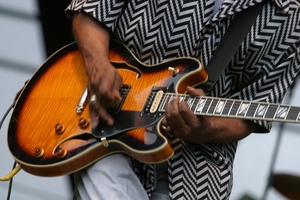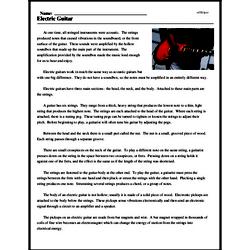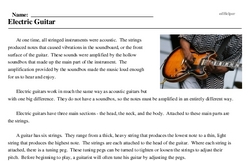Electric Guitar
At one time, all stringed instruments were acoustic. The strings produced notes that caused vibrations in the soundboard, or the front surface of the guitar. These sounds were amplified by the hollow soundbox that made up the main part of the instrument. The amplification provided by the soundbox made the music loud enough for us to hear and enjoy.
Electric guitars work in much the same way as acoustic guitars but with one big difference. They do not have a soundbox, so the notes must be amplified in an entirely different way.
Electric guitars have three main sections - the head, the neck, and the body. Attached to these main parts are the strings.
A guitar has six strings. They range from a thick, heavy string that produces the lowest note to a thin, light string that produces the highest note. The strings are each attached to the head of the guitar. Where each string is attached, there is a tuning peg. These tuning pegs can be turned to tighten or loosen the strings to adjust their pitch. Before beginning to play, a guitarist will often tune his guitar by adjusting the pegs.
Between the head and the neck there is a small part called the nut. The nut is a small, grooved piece of wood. Each string passes through a separate groove.




